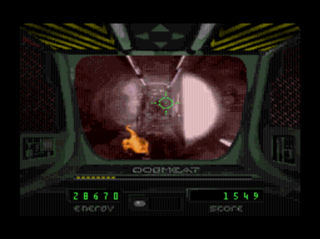|
Sewer Shark (Early Pressing) |
||||||||||||||||
| "A revolutionary new Mega CD action-adventure featuring live-actors, incredible graphics and awesome sound. Team up with ace sewer jockey Ghost to transport vital supplies via the labyrinth of rat-infested tunnels. Follow flight instructions from your navigational droid, fry the vermin, and pray you get to see the sunshine again." | ||||||||||||||||
|
|
|||||||||||||||
|
|
|||||||||||||||
|
|
|
|
 |
 |
|
 |
 |
|
|
Sewer Shark was Tom Zito's second game (Night
Trap was the first), funded by Hasbro Interactive for a console named
Nemo that was never released. After it was made in 1987 it was
placed into storage until game technology progressed to the point where it could
be released. As a new Sewer Jockey, it's straight in at the deep end, tasked with cleaning up the sewers. You have two companions on your journey - the automated robot "Catfish" who travels ahead of you opening tunnels and sending you directions, and your co-pilot "Ghost", who doesn't actually appear to do anything other than make disparaging remarks and get on your nerves like you wouldn't believe. Starting off as "Dogmeat", success in the tunnels will earn you promotions and more complimentary call signs, as well as leading to ever more dangerous areas. You have three main tasks. Firstly the obvious one - if it moves, shoot it using the gatling gun. The d-pad controls an on-screen reticule, and it's a simple case of line it up and fire. Secondly, Catfish (and sometimes other jockeys) will give you directions in sets of three, and when you approach a turn in that direction it's up to you to steer the craft by holding "B" whilst pressing the right direction. A set of arrows at the top of the screen light up green to show when a turn (whether you need to head in that direction or not) is coming up, yellow if you're almost upon it and you need to go that way, and red if you've gone the wrong way. Finally later levels may contain dangerous levels of hydrogen gas, which you need to detonate with a flare by pressing "C" when the gauge under the windscreen goes red. So a fun, on-rails shooter then? Almost, but not quite. Apart from the major irritation that is Ghost, what really grates is the assorted number of ways you can be booted out of the game. The ship has an energy level that is consumed both through flight and hits taken from the sewer's inhabitants - and if this reaches zero then it's game over. Fair enough, you have to be mortal in some way, but as the game isn't split into levels your only hope is a series of recharge points dotted around the tunnels. Ghost will warn you when one is coming up, but each has a left and right entrance - only one of which will be operational. Red and green lights show which way to turn, but if you miss one or go down the wrong side, chances are that you've had it, as you won't reach the next one in time. Directions for turns must be followed, as though the manual says Catfish will try to find you and give you new directions, nine times out of ten that you miss a turn you'll go screaming into a wall - game over. If the game decides you haven't scored highly enough by a given point - game over (with a nice cut scene featuring the guy in charge of the operation). And when this happens it's back to the start - no lives, continues or codes here, though there is a cheat that will allow you to continue if you've reached a certain rank. An early game or not, the FMV is good - very good, even considering that Digital Pictures specialised in the technology. The view through the cockpit of your craft allows the game to use quite a small window for showing the footage and get away with it. The 2D sprites of the sewer's inhabitants are a little flat and badly scaled, but the pace of the game means you don't really notice. Sound is good and even the acting is passable by video game standards. Sewer Shark was an excellent showcase early in the Mega-CD's life, and has that "wow" factor that would pique your interest if you saw it running in a game store. However, the lack of any real feeling of progression through the game, combined with a lack of "just one more go" when you're not quite sure what went wrong last time, means that it's difficult to stick with it through to the end. |
||
| This game came in a large US-style box. A later pressing with a BBFC rating printed on the CD was also released. | ||


%20CD.jpg)